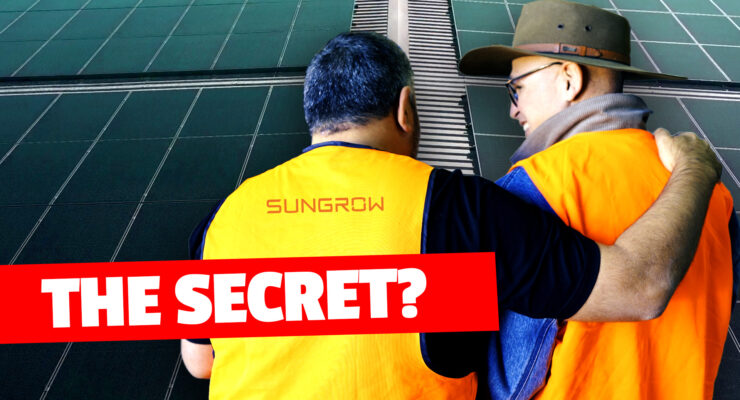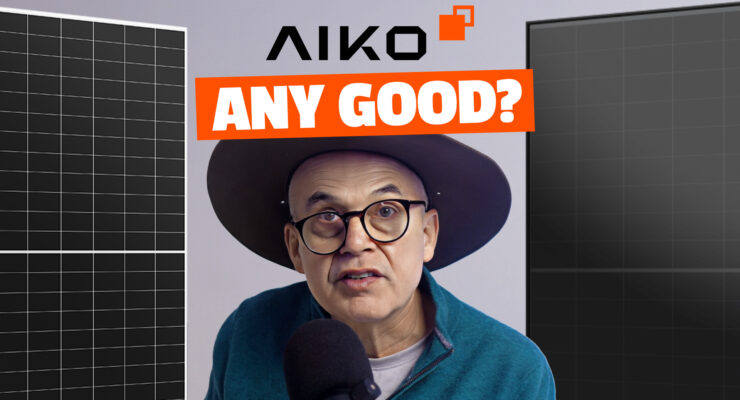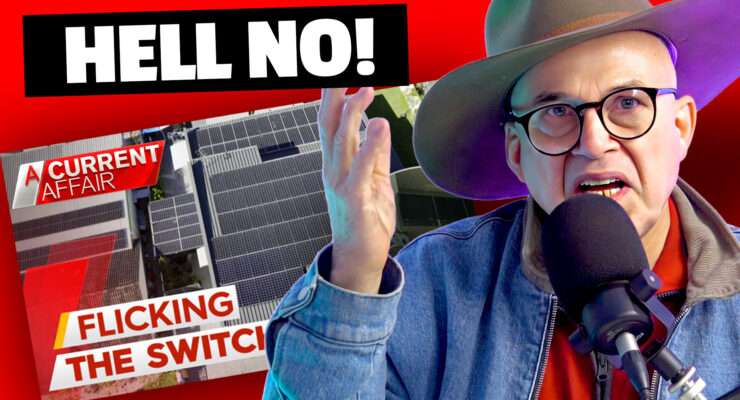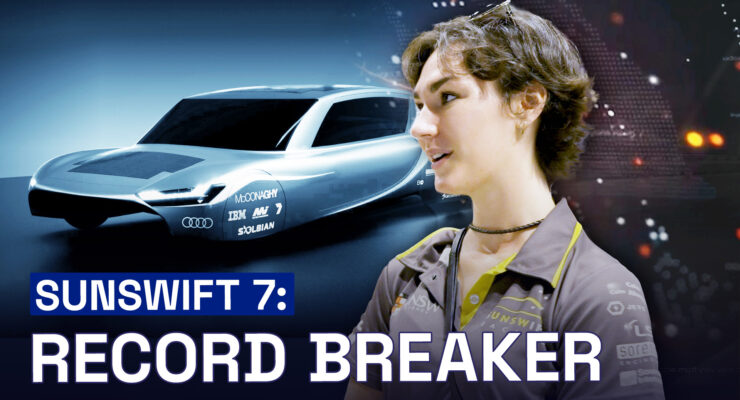
Fast read
Anna Matthews, a young engineer from the Sunswift Racing Team at UNSW, spoke with Markus Lambert about their team's developments in renewable energy, specifically in electric vehicles.
The team recently broke a world record by driving a student-built electric car for a thousand kilometers on a single charge in under 12 hours, showcasing the potential of renewable technology.
The car uses specially designed solar panels as a supplementary energy source and a rechargeable battery as the primary power source. Despite the solar panels not fully powering the car, they do provide an extra 26 kilometers of range, which contributes to the vehicle's impressive efficiency.
Matthews also discussed the gender balance within their team and expressed her enthusiasm for more women joining the engineering field.
World record by Sunswift Racing Team, from the University of NSW
Anna Matthews: We completed a world record in Melbourne, so it’s nice to kind of demonstrate what students at uni can actually do. Like breaking world records with the vehicles we’re making.
Markus Lambert: Oh, you should be in marketing.
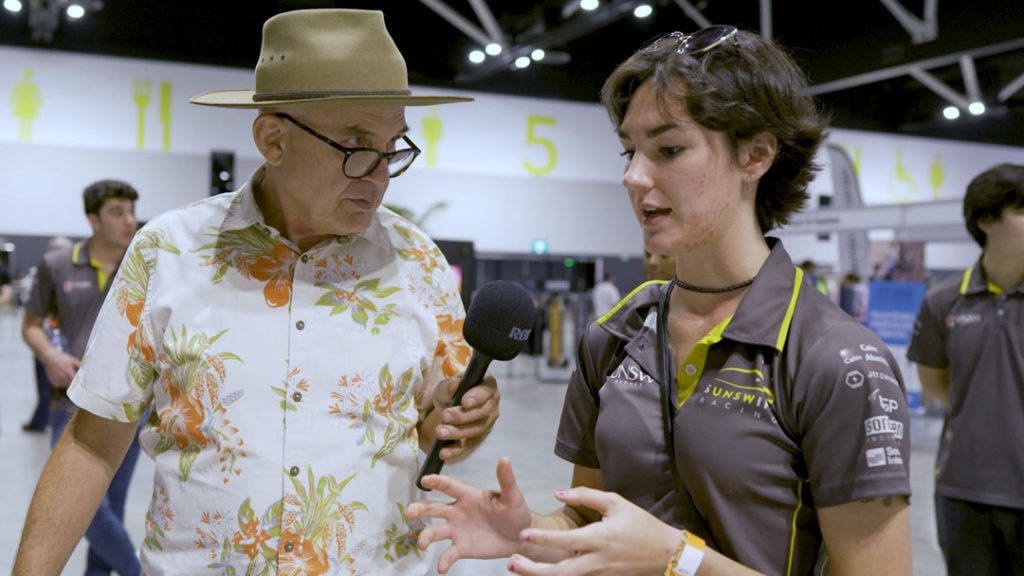
Markus Lambert introducing the show
One of the most exciting fields in renewable energy is now the development of. Electric Vehicles. But today, we’re not talking about Teslas or BYDs, but we’re talking about our own Aussie homegrown EVs. I had the pleasure of interviewing an amazing young engineer working with a team on the World Solar Car Challenge for UNSW.
So here is Anna Matthew from the Sunswift racing team, and I love her passion and knowledge.
Anna had an answer for everything
Markus Lambert: If we look at this car, it actually looks very comfortable. Normally these solar challenge cars, you kinda lie half backwards with your knee under your chin, and you can’t be more than 12 kilos.
Anna Matthews: Yeah, so we compete in a different class to all of the other ones that we’re seeing here today. We compete in the cruiser challenge, so those cars have to be able to fit four people in and sort of designed to be more like a commercial car.
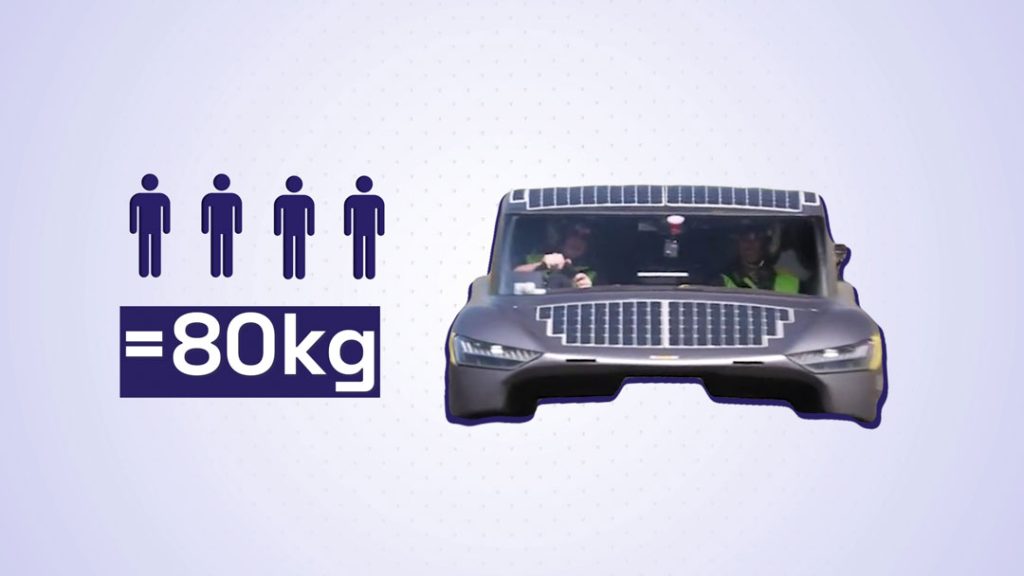
Markus Lambert: So if I’m 81 or 79kg , I can’t join the team.
Anna Matthews: No, so what we do is we put weight on our drivers. There is a driver selection process. Obviously, you have to be a certain height so you fit in the car and a certain weight so they can pack weight onto you. So they usually go with people who are lighter than that threshold and then just pack weight on them.
Markus Lambert: I see, so this is much more comfortable. And where do you drive it around?
Anna Matthews: So we do most of our testing at Sydney Motorsports Park. They’re one of our partners. We do all of our track days and testing down there, which we completed a world record in Melbourne, and our battery has a 38-kilowatt-hour capacity.
We did a thousand kilometres on a single charge by an electric vehicle. It got a thousand kilometres in under 12 hours. If we weren’t trying to like to push that limit, you could get 1300 kilometres out of a single charge of this battery.
Markus Lambert: Wow, congratulations, and what did you get? 30, 40 or $50,000. What was the price?
Anna Matthews: The Guinness World Record. Our previous car has a world record, so it’s nice to kind of demonstrate what this technology and what students at uni can actually do. Like breaking world records with the vehicles, we’re making.
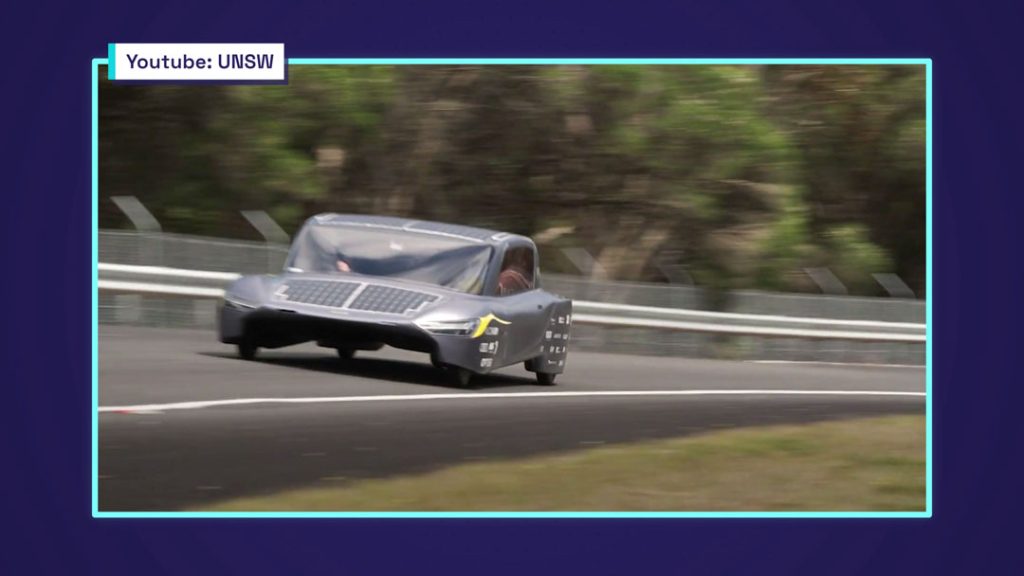
Markus Lambert: Oh, you should be in marketing.
Markus Lambert: And what, what cells you got on there?
Anna Matthews: So these are half cut; they’re just regular monocrystalline cells.
Markus Lambert: So are they taken out of a panel, or are they stick-on modules?
Anna Matthews: No, so they were designed for this car. We partnered with a company in Italy for them, and they are SunPower cells. They are one of our sponsors.
But the student team designed themselves. They designed the solar arrays for wherever they were, putting them on the car, and the company made them. And we got these solar panels that now we have a recess in the body panels. We silicone them in. They are designed specifically for this car.
Markus Lambert: So this car never gets plugged into a wall. It always gets fully charged by the cells.
Anna Matthews: No, no, a battery sits in the back. We don’t have it here today. It does get charged.
Markus Lambert: So the solar’s really only a top-up, is it?
Anna Matthews: It’s a top-up. That’s what it’s designed to do. And it’ll…
Markus Lambert: And it’ll make it look all sexy.
Anna Matthews: Yeah, it looks good, and you do get 26 kilometres out of these solar panels; they generate 1.2 kilowatts of power. So for your average kind of daily drive around the city driving to work, that’s enough, 26 kilometres.
Markus Lambert: Got it. Most people would’ve actually thought that all these solar panel bits here would power the car fully, but when you drove your thousand Ks, you really had to plug it into the wall socket somewhere.
Anna Matthews: So yeah, when we drive it, we do plug it in so the battery gets charged fully, and that’s 38 Kilowatt Hours from charging it.
What solar is designed to do is. Basically, it extends the range that we get. So when we are doing the World Solar Challenge Race, we’ll be figuring out when the solar panels are gonna be giving us that extra juice, and then we can push the car further to kind of get quicker between those checkpoints.
We can meet each other faster and we can conserve battery power at the same time because the solar’s doing more of the work at that point.
Markus Lambert: And do you drive it? Oh, I want to, I want to. I’ve only been on the team for about six months. Now, we’ve had a couple of track days, but it’s mostly been holidays for that time. But I’ve applied, I’ve applied to drive at the Bridgestone World Solar Challenge.
Apparently it’s really, really hot in the car as long as I can kind of survive the high temperatures. And apparently it’s a little bit like driving a go-kart sometimes. It is so light that you get blown around by the wind a lot. Right? But it’d be, so cool to be able to drive it.
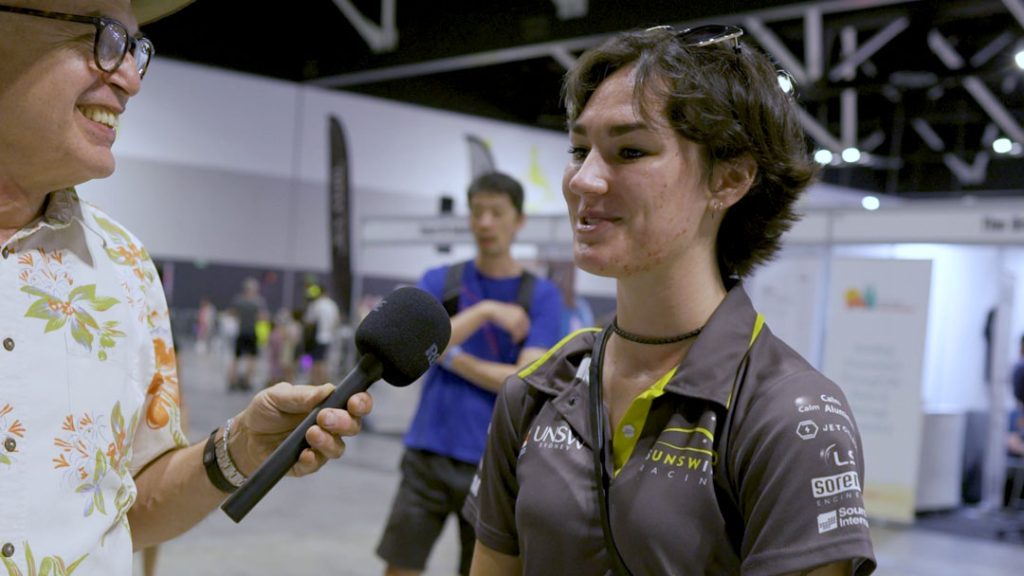
Markus Lambert: At UNSW, you got that photovoltaic department that has invented a couple of world records in solar too.
Anna Matthews: Yeah, so Martin-Green is like one of the godfathers of solar. I’m actually part of that school. It’s so cool to be able to because we at UNSW have all these facilities to be able to kind of work with our solar panels at uni. So we’re doing a lot of testing of our solar panels ourselves in those facilities.
Markus Lambert: I know that there are quite a few inventions that all come out of that university, including, I think, the P-type solar panel, that technology, but somehow it all got sold to China.
Anna Matthews: We don’t have very many manufacturers of solar cells in Australia, so at UNSW, we’ve basically got a pilot line manufacturing facility, and it takes a while to be able to manufacture cells. Even from there, it’s not designed to kind of produce in a commercial sense, and that’s where I guess China has those facilities and has those resources, and it is a lot easier to get solar made there.
Markus Lambert: Would you be surprised if I tell you BP Solar used to make solar panels in Australia?
Anna Matthews: In Australia? I would be, yeah.
Markus Lambert: Yeah. At one stage, it was the largest factory in the southern hemisphere, and Telstra was the largest installer of solar in the world.
Anna Matthews: It makes sense that Australia would have a lot to do with it, but I guess, yeah, the lack of focus on it recently, I would say.
Markus Lambert: Do you think because of the governments we had?
Anna Matthews: There’s a bit to do with government, but yeah, with all the renewable technologies, China’s the world leader in offshore wind, and it’s, it’s a world leader in a lot of technologies and renewables because it has a government that will like put money into it cause it wants to be a world leader in it.
Markus Lambert: So, how does that make you feel? I mean, why did you go into renewable in the first place? As a young person?
Anna Matthews: I am good at maths, and I care about the environment, and I wanna make a difference with the fact that I can do maths. I couldn’t enjoy anything more like the degree itself, but working as a high-performance application of what I’m learning as well at Sunswift has just been a dream.
Markus Lambert: What about as a female engineer, how does it feel to wipe the floor with some of the boy’s engineers? How’s that feeling?
Anna Matthews: Oh, it feels great. You look at the leadership team on Sunswift at least, and the proportion of women on the team is growing, but there’s still only something like 15 out of the 90 people on the team are women.
But, you see the leadership team, and you’d think that there’s a much higher proportion of women on the team because they are, they do the work. They, they are the, they are the faces of the, like our team manager, Shere and our previous team manager, like our previous team managers have all been strong women in engineering.
So many people in leadership positions in the team are women. I think it kind of shows you, I mean, you have to be pretty passionate to apply. Kind of like I wasn’t too convinced, and I was not much of a car person. I’m being kind of turned into a car person now.
But if you’ve applied to the team as a woman, you’re kind of doing it with, like, I’m really passionate about this. And I think it kind of shows by, like, the amount of work that we do on the team.
Markus Lambert: I think you showed it today. Thank you so much.
Markus Lambert’s final word
Wow. Every hurdle, every question, and Anna just went over it and conquered it, and in such style and enthusiasm, I’m sure she can talk underwater.
Very impressive. If this is the calibre of young female engineers in Australia, then our engineering future in renewables really looks bright.
We hope you enjoyed the show. If you did. Please support us by subscribing, liking it, dropping a comment, whatever. Let us know if there’s anything you would like us to do to improve the shows and for future episodes. So stay charged. Stay cool. See you in the next one.
Want more energy answered? Visit YourEnergyAnswers.com for quality energy products, tools and calculators and find your quality local installers. Please support the channel by liking the video. Hit that subscribe button ring the bell and check out all our other videos. You’re still here. I’ll see you next time. Bye.
